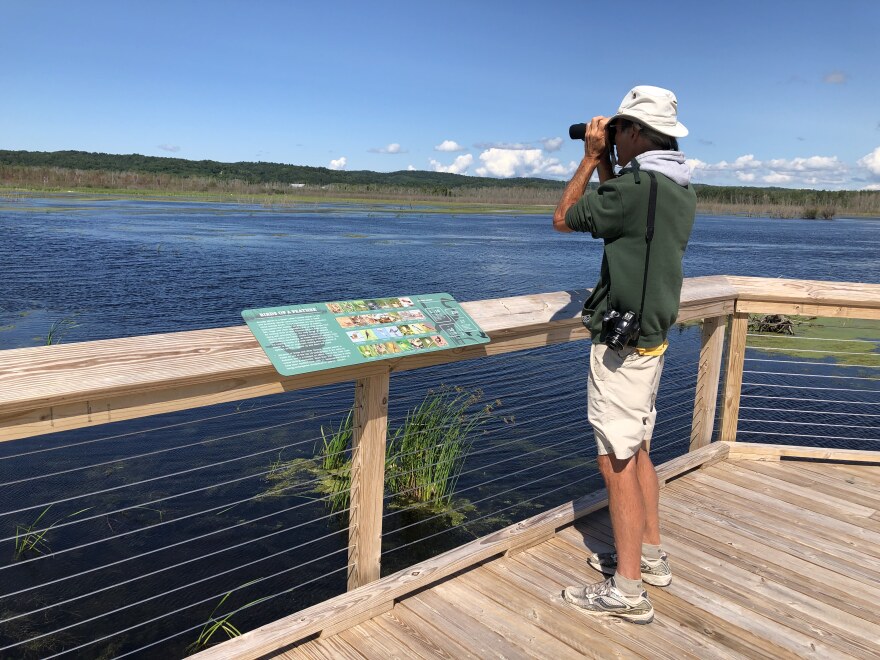Brian Allen was kayaking through Arcadia Marsh when something big and white dove at him. He had to use his paddle to defend himself from the attacker — a mute swan.
But the incident hasn’t kept Allen, an avid birder, from the marsh.
“If I could be God or have God-like powers, I’d like to do a hundred things to make this marsh better,” he says.
“But the two main ones would be to get the water level lower, and the most important thing would be to get rid of the mute swans.”
Water levels have risen two feet over the last few years in the area, as climate change brings more extreme rainfall to the region. While many other birds struggle with high water levels, mute swans thrive.
“Couple days ago I counted 117 mute swans here,” Allen says at Arcadia Marsh.
The birds, originally from Europe, were brought to Michigan in the early 1900s to decorate parks and homes.
The species is very territorial and will attack pretty much anything too close to its nest.
“They’ve gone through areas where other birds nest, and they stamp their eggs and destroy the nests,” Allen says. “And they’ll directly attack other waterfowl too.”
They also destroy plants that serve as fish habitat and food for other birds.
A full-grown mute swan eats six pounds of food every day, and destroys an additional six pounds, according to Allen.

When the birds forage, “they waste about 50% of what they’re kicking up,” Allen says. “It’s not only ducks and geese and other swans that are affected, but all the life in the wetland.”
This grazing especially affects migratory birds, who rely on wetlands like Arcadia Marsh to rest and refuel.
With high water levels limiting where they can land, and mute swans leaving them little to eat, migratory birds are running out of places to go, according to Allen.
And in many places like Arcadia Marsh, mute swans have no predators.
The Michigan Department of Natural Resources counted nearly 16,000 mute swans in Michigan in 2010.
“It was right around that time we decided we really needed to take mute swan control a lot more seriously,” says Barbara Avers, a wildlife biologist for the state.
The state set a goal to knock the mute swan population down to less than 2,000 birds by 2030. The COVID pandemic prevented a 2020 count, but as of 2019, there were about 8,000 mute swans left in Michigan.
Most of the time, the DNR controls the population with firearms.
The DNR has been on track to reach their 2030 goal, but a recent study from Central Michigan University shows that might change.
It found that more mute swans are beginning to move into urban areas.
Runoff from cities fills wetlands with nutrients, which allows for a lot of plant growth to support swans’ demanding diets. And because mute swans were once domesticated, they might actually like living closer to people, according to the study.
People like living close to swans too, and many wouldn’t like to see them killed, according to Avers.
Previously, the DNR has mostly shot mute swans on state-owned land away from people, so citizen interference hasn’t been a huge issue.
But Avers says controlling the population in urban areas definitely complicates things.
The DNR can only remove swans if they receive a request from a property owner to do so.
And people in cities who enjoy the swans are not likely to ask that they be shot.
“Those urban center populations might serve as refuges that repopulate other areas across the Great Lakes,” explains Thomas Gehring, author of the study.
At Arcadia Marsh, land managers are working on a plan to decrease the mute swan population, without upsetting the public.
A spokeswoman for the Grand Traverse Regional Land Conservancy, which manages the area, declined to discuss details.
Allen understands the public’s appreciation of mute swans, but he thinks it’s important that people know the true cost of their presence.
“Think of all the other birds that migrate through here,” he says. “There’s so many other good things out here that need these places too.”

